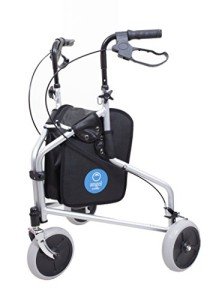
Rollator With Brakes
Add a review FollowOverview
-
Founded Date November 7, 1955
-
Sectors Construction / Facilities
-
Posted Jobs 0
-
Viewed 21
Company Description
See What Rollator With Storage Tricks The Celebs Are Using
Rollator with Storage: A Comprehensive Guide for Independent Mobility
Rollators are mobility aids developed to help individuals with walking difficulties while promoting self-reliance and safety. Unlike traditional walkers, rollators come geared up with wheels for simple and easy navigation, making them an essential tool for numerous elderly and disabled individuals. One of the crucial functions that improve the performance of rollators is storage. This short article checks out rollators with integrated storage alternatives, highlighting their benefits, types, and crucial factors to consider when picking the right design.

Understanding Rollators
What is a Rollator?
A rollator is a wheeled walker that provides support for individuals who may struggle with balance or endurance. Generally, rollators are created with the following features:
- Wheels: Rollators are geared up with either two or four wheels, enabling smooth maneuverability.
- Hand Brakes: Most have hand brakes for added safety, making it possible for users to control their speed.
- Seat: Many models include a built-in seat, offering a resting point when required.
- Storage: Rollators frequently come with baskets or bags for carrying personal products like water bottles, groceries, or medical materials.
Benefits of Using a Rollator with Storage
The inclusion of storage alternatives in rollators brings numerous benefits:
- Convenience: Users can quickly carry personal belongings, decreasing the need for additional help.
- Self-reliance: Having access to necessary items while being mobile empowers individuals to keep their self-reliance in various environments, such as grocery stores, parks, or homes.
- Safety: By securely saving products, users can more with confidence navigate their environments without the danger of dropping important goods.
- Comfort: Having a seat for resting enables users to take breaks when needed, even more improving mobility.
Types of Rollators with Storage
A number of kinds of rollators come geared up with storage options:
| Rollator Type | Description | Appropriate for |
|---|---|---|
| Requirement Rollator | Typically features four wheels and a sturdy frame. Storage choices, like an integrated bag or basket, are often consisted of. | General use, outdoors |
| Compact Rollator | A smaller sized version that folds easily for transport. While these designs typically have actually restricted storage, lots of still include very little functionality. | Tourists and tight spaces |
| Sturdy Rollator | Designed for larger people, these rollators typically have better storage capacity. | Bigger users, stability needs |
| Rollator with Seat | Functions an integrated seat for resting. Storage choices vary, often including baskets or shopping bags. | Those requiring routine breaks |
| Walker-Carrier Combo | Function as both a rollator and a lightweight cart, perfect for shopping journeys. | Grocery shopping, outdoor use |
Selecting the Right Rollator with Storage
When picking a rollator with storage, a number of elements ought to be considered to guarantee that it meets individual needs.
Secret Features to Assess
- Weight Capacity: Always check the weight limitation of the rollator to guarantee safety and use.
- Size and Foldability: Consider how the rollator fits in your living space and whether it can be easily kept or transported.
- Storage Capacity: Assess the size and ease of access of storage compartments. Try to find options that permit safe and secure storage without overwhelming the user with complexity.
- Adjustable Handles: Ensure that the manages can be changed to the proper height to improve comfort and ergonomics.
- Braking System: A reputable braking system is vital. Make sure the brakes are easy to engage and disengage.
- Wheel Size and Type: Larger wheels can browse rougher surface, while smaller sized ones may be preferable for flat surface areas.
Additional Considerations
- Devices: Many rollators have optional accessories, such as cup holders or seat cushions, to improve user experience.
- Guarantee and Support: Investigate whether the manufacturer offers a warranty for flaws or damages.
- User Reviews: Online consumer evaluations can use valuable insights into performance and fulfillment.
Maintenance and Care of Rollators
To guarantee longevity and optimal performance, regular maintenance is essential. Users need to consider the following practices:
- Regular Cleaning: Wipe down the frame and parts to avoid rust and preserve health.
- Inspect Brakes: Ensure that the brakes are operating properly and change them as needed.
- Inspect Wheels: Regularly look for any debris caught in the wheels or signs of wear and tear.
- Tighten Hardware: Periodically examine and tighten screws or bolts to maintain safety.
Frequently Asked Questions (FAQs)
1. How do I choose the ideal size rollator for me?
Picking the best size includes examining your height and weight, in addition to monitoring handle height adjustments to make sure that it is ideal for your stature.
2. Can I use a rollator on unequal surface?
Yes, some rollators are created with bigger wheels and shock-absorbing systems that make them more appropriate for unequal terrain. It’s vital to inspect the specifications.
3. Is it easy to fold a rollator for transport?
A lot of modern rollators are designed to be quickly foldable. Try to find instructions in the user handbook that accompany your picked design.
4. Just how much weight can a normal rollator support?
Many basic rollators support in between 250 to 350 pounds; however, sturdy designs can support higher weights.
5. Can I include accessories to my rollator?
Yes, numerous rollators featured the alternative of adding accessories like cup holders, trays, and bags to improve functionality.
In summary, a rollator with storage is an important mobility aid that empowers individuals while providing them with the convenience of transferring important items. By understanding the various types, key functions, and upkeep requirements, users can confidently pick the ideal rollator that fits their way of life, promoting independence and comfort in everyday activities. As mobility aids continue to evolve, they end up being increasingly vital for improving the lifestyle for elderly and disabled individuals.



